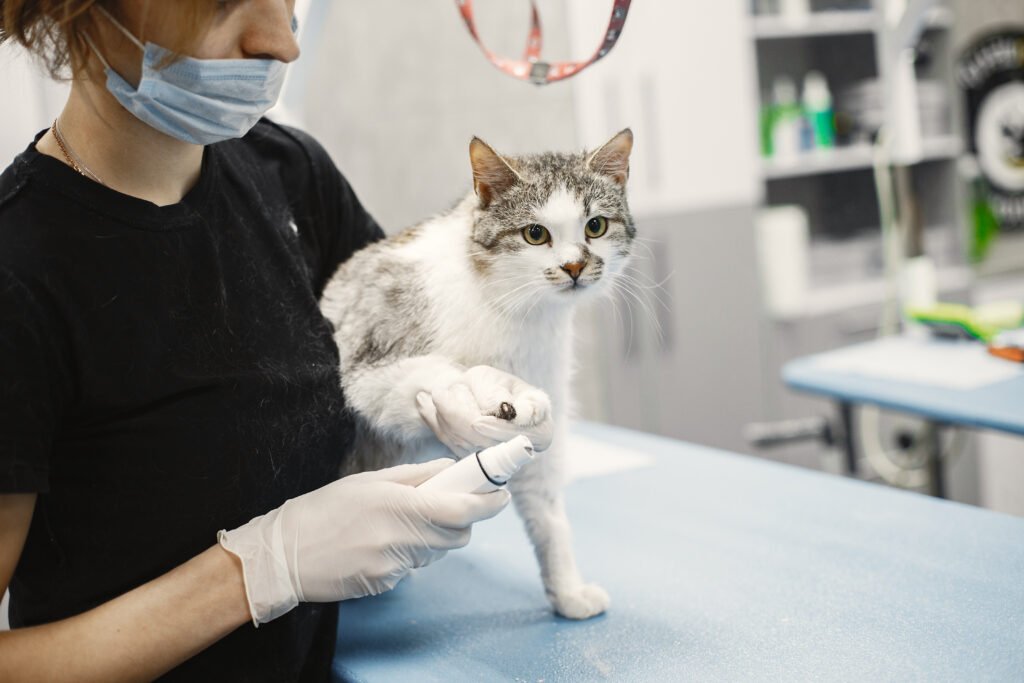Are vaccines harmful and could my pet have an allergic reaction?
Your pet can be allergic to vaccines, which is rare, of course, but this is something at the back of my mind. The significance of this risk recognition and management can hardly be understated if optimal health is what you wish for. Vaccinations protect you against dangerous diseases, but if you are allergic to the cat rabies vaccine side effects, they will cause an allergy and lead not only to the edema of mucous membranes or urticaria (skin rash), but also life-threatening conditions such as bronchospasm and generalized swelling. Recognizing the signs, following best practices for prevention, and knowing exactly what to do in an emergency should a reaction happen will keep your pet safe but also protected against infectious disease.

Signs of an Allergic Reaction to Vaccines in Pets include cat rabies vaccine side effects.
The most common ways an allergy to a vaccine will present in your pet usually ranges between mild, moderate and severe; below are some of the typical symptoms seen:
Injection site pain, swelling
A swollen area on your vaccination site is one of the earliest signs you will see. It may feel like a very small lump or bump just under the skin and can be painful with your fingers. There is little harm in minor swelling, and most of it subsides spontaneously; however serious or long-lasting inflammation may represent a worse response.
Hives or Skin Irritation:
This results in a hive presentation with raised, red, and may be itchy skin patches on the pet’s body. Such a reaction is typically reported within hours after vaccination. It can either be localized or generalized on the body as a whole. The pet may in turn start scratching or licking more and make the problem worse.
Vomiting and Diarrhea:
Allergic reactions can also cause gastrointestinal upset including vomiting or diarrhea. This can happen immediately after the vaccination or after a few hours [48]. If those signs are severe or long-lasting, it is time to see your local vet.
Facial Swelling:
Angioedema, a more severe allergic response that causes swelling around the face — especially in or near to eyes, muzzle and throat. It tends to get worse over the course of 24 hours and can also affect your airways, causing breathing problems.
Difficulty Breathing:
Some pets may end up having trouble breathing from their airways swelling, or develop a more systemic allergic reaction, which could be deadly such as anaphylaxis. This is a critical condition that needs to be addressed by your veterinarian immediately.
Lethargy and Weakness:
Some lethargy can be a normal response, but if it is excessive or your dog suddenly gets weak after getting vaccinated, that could signal an adverse reaction. The pet might seem overly lethargic, reluctant to get up and around or apparently unsteady on their feet.
Collapse or Seizures:
In severe cases, anaphylactic shock and fainting or seizures release it. Anaphylaxis can happen when the pet has a very strong immune system reaction to the vaccine. This is when prompt emergency care should be availed.
These are symptoms that should alert you to consult your vet immediately once the pet has been vaccinated for more. The symptoms may not be severe at first, but let them slip and they will get worse. Your vet may prescribe antihistamines, steroids, or other treatments to control the reaction and for more severe cases hospitalization could be used if needed.

Vaccinating My Pet With the Lowest Possible Chance of Allergic Reaction
Avoiding an immediate-type allergic reaction of your pet when getting vaccinated requires planning, good communication with your veterinarian and vigilance. Here are some key strategies:
Ask Seriously: Understand Your Animal’s Medical Background
Keep an accurate and detailed dog medical history for your vet, including records of any past adverse reaction to vaccines or drugs given. This provides information for a vet to determine if an allergic reaction is likely and perhaps not use that particular vaccine or make the decision to give antihistamines before vaccination.
Pre-Vaccination Medications
- Some pets have prior vaccine reactions that your vet may want to pre-treat with antihistamines or steroids before vaccinating. The immune system is soothed and will not respond in an hyperactive way to the vaccine.
- Use Individual Vaccines If Available: Choose Single Vaccinations when possible.
- Convenient combination vaccines (which protect against more than one disease) may be associated with a higher risk of allergic reactions because they contain many components. For pets with previous reactions you can enquire whether it is feasible to give single vaccines separately (rather than a combination vaccine) and spaced apart.
Remain on the Vet Clinic After Vaccine
Stay at the veterinary clinic 15 to 30 minutes after your pet gets its vaccine. This is also when many of the allergic reactions happen anyway — but if your pet DOES react, at least they can go to their doctor right away for treatment. Even once you leave, monitor your pet for a few hours.
Demand Vaccines from Respected Manufacturers
When administering vaccines, make sure your veterinarian uses vaccines from reliable producers who have proven high standards of quality. Although no vaccine is 100% safe, the aim of modern vaccines that are kept to a high standard meant they were less likely to cause any trouble.
Space Out Vaccinations:
If your animal requires multiple vaccines, consider giving some at different visits rather than all together. This allows for less stress on the immune system of your furry friend and also makes it easier to pinpoint which vaccine in particular caused a reaction.
After Vaccination, Keep Your Pet under Surveillance
Watch for signs of an allergic reaction (hives, swelling around the face, vomiting or difficulty breathing) after vaccinating your pet. For treatment to be as effective as possible, detection must happen early. Remember, if you ever see any worrying signs – consult your vet.
Discuss Vaccine Necessity:
Match with your vet to find a combination of vaccines that might be appropriate for you, and avoid over-vaccinating. Some vaccines are required, while others might only be necessary in certain situations or optional altogether. Decreasing the number of vaccines can reduce the chance that a reaction will occur.
Taking these precautions and working closely with your veterinarian can ensure the safest vaccine for your pet.

Responses to allergic reactions of vaccines in your pet
If your pet exhibits any symptoms of an allergic reaction to the vaccine, it is vital that you take appropriate steps immediately. Here’s what you should do:
1.Recognize the Symptoms
So, the first thing is familiarizing yourself with typical signs of an allergic reaction — i.e., swelling in face or site where patient was injected (in mild cases), hives over body if moderate-severe reactions to be expected like having a vomiting and diarrhea + rashes which means we are leaning more towards severe spectrum; even lethargy loss of conscientiousness can be deadly. Weight Collapse!!!! Early identification of these signs are important for early intervention.
2.Contact Your Vet Right Away
If you see any symptoms of an allergic reaction, tell your vet immediately. Symptoms that do not appear too severe can escalate quickly. If you have a pet emergency, your vet can give some phone advice and let you know if the issue is severe enough that he or she needs to come in for immediate care.
3.Give Antihistamines ( If Prescribed)
The recommendation of antihistamines your vet has previously endorsed should you pet suffers from mild allergies, they may tell you to administer a dose. But always under veterinary guidance, and since the dose is important whether it be a huge or tiny pet society.
4. Keep Your Pet Calm and Comforted
Keep your pet as calm and comfortable while you wait for veterinary advice or transport to the clinic. Symptoms can worsen with stress so ensure your pet remains calm in a quiet environment. Do not feed your pet during this time, especially if they are vomiting or nauseous.
5.Plan for an Emergency Transport
If your pet has severe symptoms (struggling to breath, extreme swelling or collapsing), be prepared to transport your pet immediately. When it comes time to move, having an emergency mode of transportation can help out tremendously.
6.Obey the Vet
At the vet clinic, simply follow your veterinarian’s instructions. Treatment may involve providing antihistamines, steroids or epinephrine to mitigate the immune system response. In the worst cases, your pet may require hospitalization for monitoring and supportive therapy including intravenous fluids or oxygen.
7.Monitor for Delayed Reactions
This is the reason you need to continue observing your pet even after administering treatment, as some allergic reactions might take more than 24 hours before showing up. If prescribed medications — follow through with those as well and if you have to go back for another check up then make that appointment.
8.Report the Reaction
Ensure that the allergic reaction is recorded in a veterinary chart. This is important information for any future vaccinations or treatments and can allow your vet to take precautions, such as pre-treating with antihistamines that would be given prior vaccination (you cannot not give a vaccine on the day).
9.Talk About the Future Vaccinations
Once your pet is better, make sure to consult with a specialist on vaccination. They will often recommend changing the timing of when vaccinations are given, altering which vaccine formulation is used or pre-treating adverse reaction patients with medication prior to administering future vaccines.
Prompt action and these steps can be used to control an allergic reaction in your pet, safely. Your veterinarian is your most important resource during this time, so take advantage.
